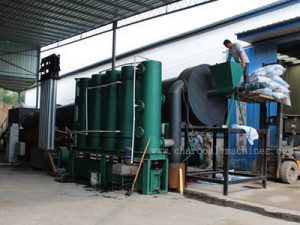Four continus de carbonisation. Quand la coquille de noix de coco est carbonisée, elle doit d'abord être écrasée et broyée jusqu'à quel point. Cela peut être déterminé en fonction des besoins du client. L'étape suivante est le séchage. Le séchage est également très important. La matière première carbonisée générale est carbonisée. Quand elle est sèche, sinon l'effet de carbonisation n'est pas bon, le degré de séchage de la coquille de noix de coco est d'environ 15 % à 20 % d'eau, elle n'est pas trop sèche. Après le séchage, elle est carbonisée. C'est aussi très important. Si la carbonisation n'est pas bien maîtrisée, elle peut être abandonnée, transformée en cendres, ou non carbonisée. À ce moment-là, l'utilisation du four de carbonisation est très importante. Comment l'utiliser ? Il y a plusieurs points à noter.
1 L'alimentation de la machine d'alimentation doit être effectuée selon l'entrée de matière de la machine de carbonisation. La condition de chute démarre et ferme la machine d'alimentation pour réalimenter la matière carbonisée. La matière du port d'alimentation inférieur ne doit pas non plus s'empiler. Il est recommandé de garder la matière dans le tube de carbonisation à environ 2/3.
2 La vitesse de la machine de carbonisation doit être ajustée en fonction de l'effet de carbone, et la vitesse de la broche doit être correctement ajustée pour assurer le rendement en carbone. (La vitesse de la broche peut être ajustée)
3 Lorsqu'il y a un débordement de fumée au niveau du siège de l'arbre aux deux extrémités de l'arbre rotatif, le boulon du presse-étoupe doit être serré à temps après le changement, et la bande de garniture d'amiante du matériau d'étanchéité doit être remplacée si nécessaire.


Sachant comment l'utiliser, l'étape suivante est le contrôle de la température. Le brûleur du brûleur est pulvérisé, le tube de carbonisation est chauffé, le thermocouple est étendu dans le corps du four, et l'espace à l'intérieur du four est affiché sur l'instrument de contrôle de température sur le panneau de l'armoire de contrôle par le fil. température. (La température réelle à l'intérieur du tube de carbonisation sera de 200 à 300 degrés supérieure à la température mesurée dans le four.) Équipement de carbonisation respectueux de l'environnement, chauffé dans le four pendant 15 à 20 minutes. Lorsque la température atteint 550 à 600 degrés, appuyez sur le bouton de démarrage de la machine de chargement, la vis dans la machine à vis tourne, et l'alimentation de la machine d'alimentation commence à alimenter. La matière de coquille carbonisée tournera le long de la spirale de la machine à vis. Le corps du tube déplacera la matière vers le port d'alimentation au-dessus de la machine de carbonisation.
Lorsque le matériau de coque de noix de coco est rempli dans l'entrée de la machine de carbonisation, appuyez sur le bouton de démarrage du four de carbonisation, appuyez sur l'interrupteur rouge du régulateur électromagnétique en position ON, et faites lentement tourner le bouton de contrôle de la vitesse pour faire indiquer au régulateur l'aiguille de déviation, indiquant environ 500-600 tr/min (adapté à la coque de noix de coco). L'auge de la machine de carbonisation est tournée par la spirale, poussant le matériau vers l'avant, en remuant et en déplaçant, dans les premier et deuxième tubes de carbonisation en haut et en bas. Préchauffage, l'eau dans le précipité est évacuée par le tuyau d'échappement. La cheminée est évacuée dans l'air, et le matériau est dans le tuyau. Lorsque un ou deux tuyaux sont secs dans le troisième tuyau, l'eau a été déposée et nettoyée. Pendant la phase de carbonisation à basse température, après une avancée, un mouvement et une agitation continus, lors de l'entrée dans le quatrième tube, le matériau est tourné, remué, propulsé et déplacé sur une distance dans le corps du tube à haute température pour compléter le passage du carbone de la température basse à la haute température. Pendant le processus de conversion du carbone, le carbone à haute température produit est finalement évacué par le port de décharge de la machine de carbonisation vers l'entrée de la machine de refroidissement et de déchargement de type à manteau d'eau, et la poudre de carbone à haute température du tube de la machine de déchargement est refroidie par l'eau de refroidissement entourant le corps du tuyau, et enfin du port de décharge de la machine de déchargement. Le toner et la suie après refroidissement, comme décrit précédemment, encore et encore, travaillant continuellement pour compléter tout le processus de carbonisation des produits en coque de noix de coco.
